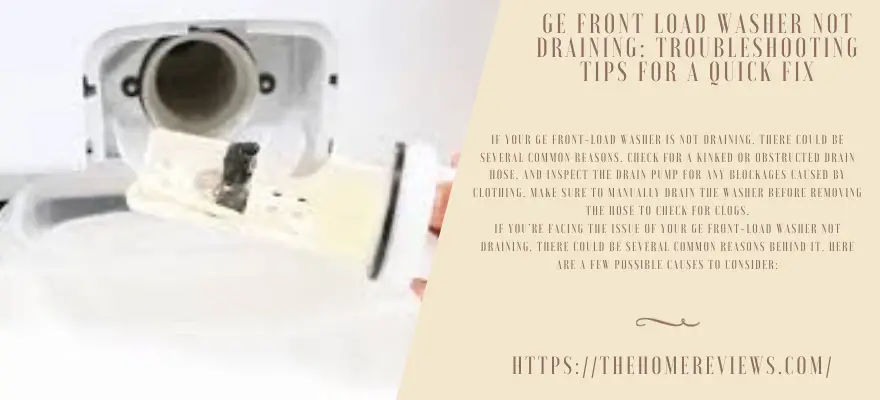If your GE front load washer is not draining, check for obstructions in the drain hose and inspect the drain pump for blockages. Manually drain the washing machine before removing the hose for inspection or unclogging.

Common Reasons Why A Ge Front Load Washer Is Not Draining
If your GE front-load washer is not draining, there could be several common reasons. Check for a kinked or obstructed drain hose, and inspect the drain pump for any blockages caused by clothing. Make sure to manually drain the washer before removing the hose to check for clogs.
If you’re facing the issue of your GE front-load washer not draining, there could be several common reasons behind it. Here are a few possible causes to consider:
Clogged drain hose:
- A clogged drain hose is a frequent culprit behind a GE front-load washer not draining properly.
- Hair, lint, or debris can accumulate over time and cause blockages in the drain hose.
- To check for a clogged drain hose, disconnect it from the washer and inspect for any obstructions.
- Use a plumber’s snake or a long wire to carefully remove any clogs and restore water flow.
Faulty Drain Pump:
- The drain pump is responsible for expelling water from the washer during the drain cycle.
- If the drain pump is faulty or not functioning correctly, it can lead to drainage issues.
- Listen for any unusual sounds coming from the pump, which may indicate a problem.
- Consider replacing the drain pump if it is not working efficiently.
Blocked Filter:
- The filter in a GE front load washer helps to catch lint, hair, and other debris.
- A clogged filter can hinder proper drainage and cause water to accumulate in the machine.
- Locate the filter, which is typically located at the front of the machine behind a small panel.
- Clean the filter by removing any trapped debris, and rinse it thoroughly before reinstalling.
By addressing these common issues, you can troubleshoot and resolve the problem of your GE front-load washer not draining effectively. Remember to always consult the manufacturer’s instructions or contact a professional if you are unsure or uncomfortable performing any repairs yourself.
Troubleshooting Tips For A Clogged Drain Hose
If you’re dealing with a ge front load washer not draining, there are a few troubleshooting tips you can try. Check the drain hose for any obstructions or kinks, inspect the drain pump for blockages, and make sure to manually drain the machine before unclogging the hose. Remember, always interrupt the cycle before attempting any repairs.
If you’re experiencing issues with your GE front load washer not draining properly, one possible culprit could be a clogged drain hose. A clogged drain hose can prevent water from flowing out of the washer, which can lead to water remaining in the drum or large amounts of water pooling on the floor. Here are some troubleshooting tips to help you resolve this issue:
Inspect The Drain Hose For Clogs
- Check the drain hose for any visible clogs or blockages. Look for debris, lint, or other foreign objects that may be obstructing the flow of water.
- Inspect the connection points between the drain hose and the washer, as well as the drain hose and the drain pipe. Make sure there are no kinks or twists in the hose that could restrict the water flow.
- Remove the drain hose from the washer and the drain pipe to thoroughly inspect it. Use a flashlight to check for any clogs or blockages that may be hidden.
Remove And Clean The Drain Hose
- To remove the drain hose, locate the clamp or fastener securing it in place. Loosen or remove the clamp or fastener to detach the hose from the washer and drain pipe.
- Once the hose is disconnected, take it outside or to a utility sink to clean it. Use a garden hose or high-pressure nozzle to flush out any debris or clogs.
- If the clog is stubborn and cannot be loosened with water pressure, you can use a plumber’s snake or a straightened wire hanger to carefully push through the obstruction and remove it.
Check For Kinks Or Twists In The Drain Hose
- Ensure that the drain hose is not kinked or twisted in any way. Kinks or twists can restrict the water flow and prevent proper draining.
- Straighten out any kinks or twists in the hose, taking care not to create any sharp bends that could cause further issues.
- If the drain hose is too long and has excess slack, consider shortening it to ensure a smooth, unobstructed water flow.
By following these troubleshooting tips, you may be able to resolve the issue of a clogged drain hose in your GE front load washer. However, if the problem persists or if you are unsure about handling the troubleshooting process yourself, it is always recommended to consult a professional technician for assistance.
Troubleshooting Tips For A Faulty Drain Pump
Have trouble with your GE front-load washer not draining? Check the drain hose for any kinks or obstructions, and inspect the drain pump for blockage caused by small clothing items. To manually drain the machine, remove the hose and unclog it.
If your GE front-load washer is not draining properly, the culprit could be a faulty drain pump. Here are some troubleshooting tips to help you identify and resolve the issue:
Test The Drain Pump For Power
- Ensure that the washer is unplugged before proceeding with any troubleshooting steps.
- Locate the drain pump, which is usually located at the bottom of the washer.
- Use a multimeter to test the drain pump for power. Set the multimeter to the lowest ohm setting and touch the probes to the terminals on the drain pump. If you get a reading of zero, it means the pump has power. If there’s no reading, the pump may be faulty and needs to be replaced.
Check For Blockages In The Drain Pump
- Remove any standing water from the washer using a bucket or towels.
- Disconnect the washer from the power source to ensure safety.
- Locate the drain pump access panel, which is usually located on the front or back of the washer.
- Remove the access panel to reveal the drain pump.
- Inspect the drain pump for any debris or foreign objects that may be blocking the flow of water.
- Remove any blockages using a pair of tweezers or needle-nose pliers.
- Reassemble the drain pump and test if the washer is able to drain properly.
Replace The Faulty Drain Pump
- If testing and clearing blockages did not resolve the draining issue, it’s likely that the drain pump is faulty and needs to be replaced.
- Order a replacement drain pump that is compatible with your GE front-load washer model.
- Consult the manufacturer’s instructions or the user manual for your washer for guidance on how to replace the drain pump.
- Ensure that you have all the necessary tools on hand before starting the replacement process.
- Disconnect the washer from the power source and water supply.
- Remove the old drain pump and install the replacement pump according to the manufacturer’s instructions.
- Once the new pump is installed, reconnect the power source and water supply to the washer.
- Test the washer to ensure that the new drain pump is functioning properly and the water is draining as it should.
By following these troubleshooting tips, you can identify and resolve the issue of a faulty drain pump in your GE front load washer. Remember to follow safety precautions and consult the manufacturer’s instructions for specific guidance.
Troubleshooting Tips For A Blocked Filter
If your GE front-load washer is not draining, there are a few troubleshooting tips you can try. First, check the drain hose for any kinks or obstructions. Next, inspect the drain pump for any blockages. If needed, manually drain the washing machine before unclogging the drain hose.
Locate and access the filter.
- The first step in troubleshooting a blocked filter in your GE front-load washer is to locate and access the filter.
- Begin by unplugging the washer from the power source to ensure safety.
- Look for the filter access panel, which is usually located at the bottom of the machine.
- Use a screwdriver or a coin to remove the panel and reveal the filter.
Remove and clean the filter.
- Once you have located the filter, carefully remove it from its housing.
- Check for any visible debris or obstructions, such as lint, coins, or small objects.
- Use a soft brush or cloth to gently clean the filter, removing any accumulated dirt or debris.
- Make sure to clean both the filter and its housing thoroughly.
Check for blockages in the filter cavity.
- While the filter is removed, inspect the filter cavity for any blockages.
- Look for any lint or foreign objects that may be preventing proper drainage.
- If you notice any blockages, use a flashlight and a pair of tweezers or pliers to remove them.
- Be cautious not to damage any components or wiring inside the filter cavity while doing so.
By following these troubleshooting tips for a blocked filter, you can ensure that your GE front-load washer drains properly and keeps your laundry fresh and clean. Remember to clean your filter regularly to prevent future blockages and maintain optimal washer performance.
Additional Troubleshooting Ideas And Tips
If your GE front-load washer is not draining, there are additional troubleshooting ideas and tips you can try. Check for any obstructions in the drain hose and pump, ensure the drain hose is not kinked or twisted, and manually drain the washing machine if necessary.
Is your GE Front Load Washer not draining properly? Don’t worry; we have some additional troubleshooting ideas and tips that may help you resolve this issue.
Check for lint or debris in the washer drum.
- Inspect the washer drum for any lint or debris that might be blocking the drain. Remove any visible lint or debris to improve the drainage.
Verify that the washer’s control panel settings are correct.
- Ensure that the washer’s control panel settings are properly configured. Make sure that the washer is set to the correct wash cycle and that the water temperature and soil level selections are appropriate for your laundry load.
Inspect the washer’s water inlet valve.
- Check the washer’s water inlet valve to ensure that it is functioning correctly. A faulty or clogged water inlet valve can cause draining issues. Clean or replace the water inlet valve if necessary.
To summarize, here are some troubleshooting ideas and tips for your GE Front Load Washer not draining:
- Check for lint or debris in the washer drum.
- Verify that the washer’s control panel settings are correct.
- Inspect the washer’s water inlet valve.
By following these additional troubleshooting steps, you may be able to resolve the draining issue with your GE Front Load Washer. Remember to always refer to the manufacturer’s manual for specific instructions and safety guidelines.
Frequently Asked Questions
Why Is My Ge Front Load Washer Not Draining?
If your GE front load washer is not draining, check for kinks or obstructions in the drain hose. Also, inspect the drain pump for any trapped clothing that may be causing a blockage. Make sure to manually drain the washer before removing the drain hose for inspection or unclogging.
Why Would My Front Load Washer Not Drain?
A front-load washer may not drain if the drain hose is kinked or obstructed. Check the drain hose and inspect the drain pump for blockages. If necessary, manually drain the washer before unclogging the hose.
How Do I Force My Ge Washer To Drain?
To force your GE washer to drain, interrupt the current cycle by pressing the “Start/Pause” pad once. Then select “Drain and Spin” and press “Start/Pause” again. If the washer is full of water and the “Stop” pad is selected, choose “Drain and Spin” and press “Start.
“
Why Is My Ge Washer Leaving My Clothes Soaking Wet?
If your GE washer is leaving your clothes soaking wet, it may be due to an out-of-balance condition. Ensure that the drain hose is not kinked or obstructed, and check the drain pump for trapped clothing. Manually drain the machine before removing the drain hose.
Why Is My Ge Front Load Washer Not Draining?
The drain hose may be kinked or obstructed, or there could be an issue with the drain pump.
Conclusion
If you’re experiencing the frustration of a GE front-load washer not draining properly, there are a few steps you can take to troubleshoot and resolve the issue. First, check to make sure the drain hose is not kinked or obstructed in any way.
Next, inspect the drain pump for any blockages, such as clothing or debris, that may be causing the problem. If necessary, manually drain the washing machine before removing and checking the drain hose. Additionally, you can try interrupting the cycle and selecting the “Drain and Spin” option to force the washer to drain.
Remember, always prioritize safety and consult a professional if you are unsure or uncomfortable performing these tasks yourself. By following these tips, you can resolve the issue of a GE front-load washer not draining and get back to efficiently washing your clothes.





